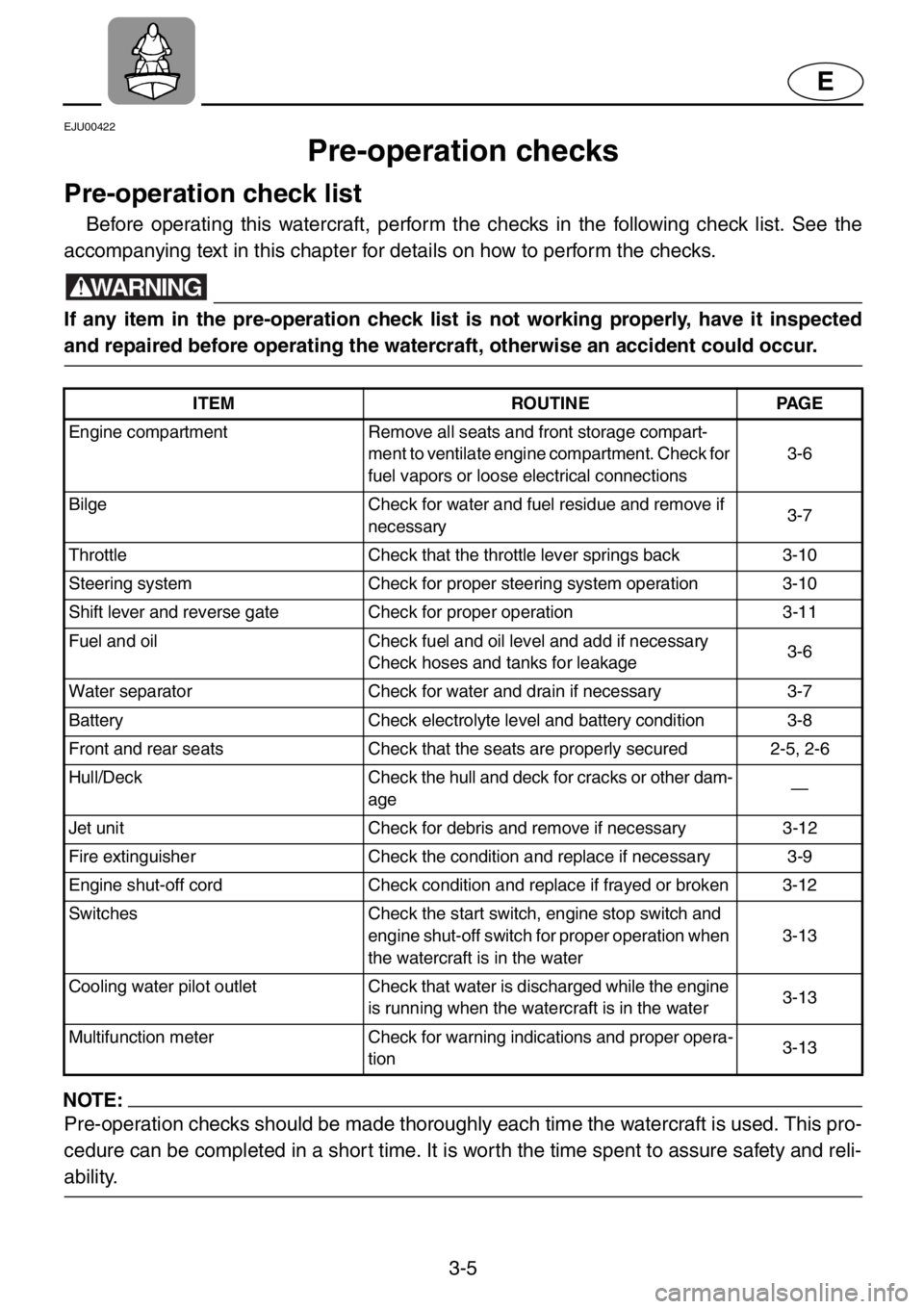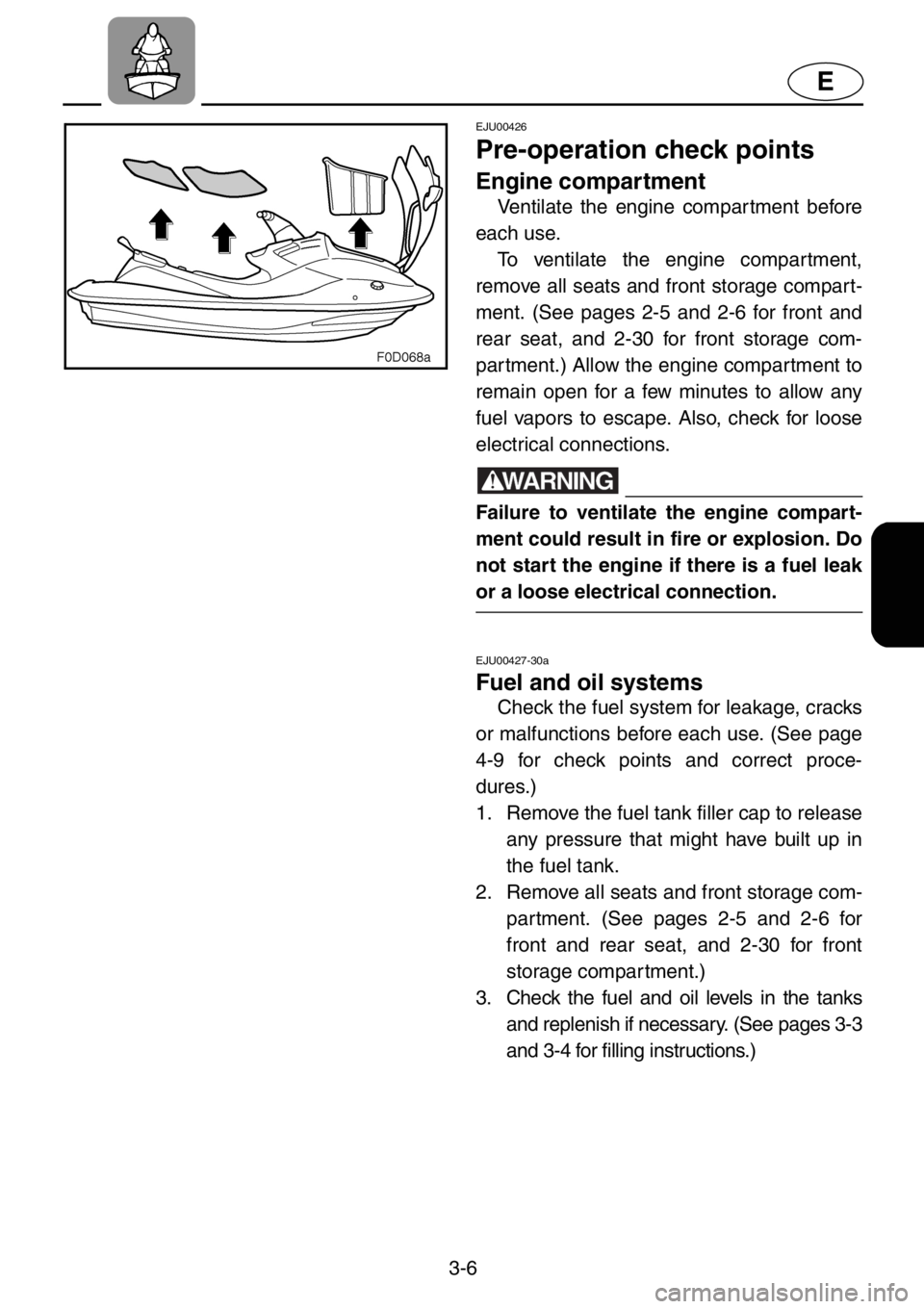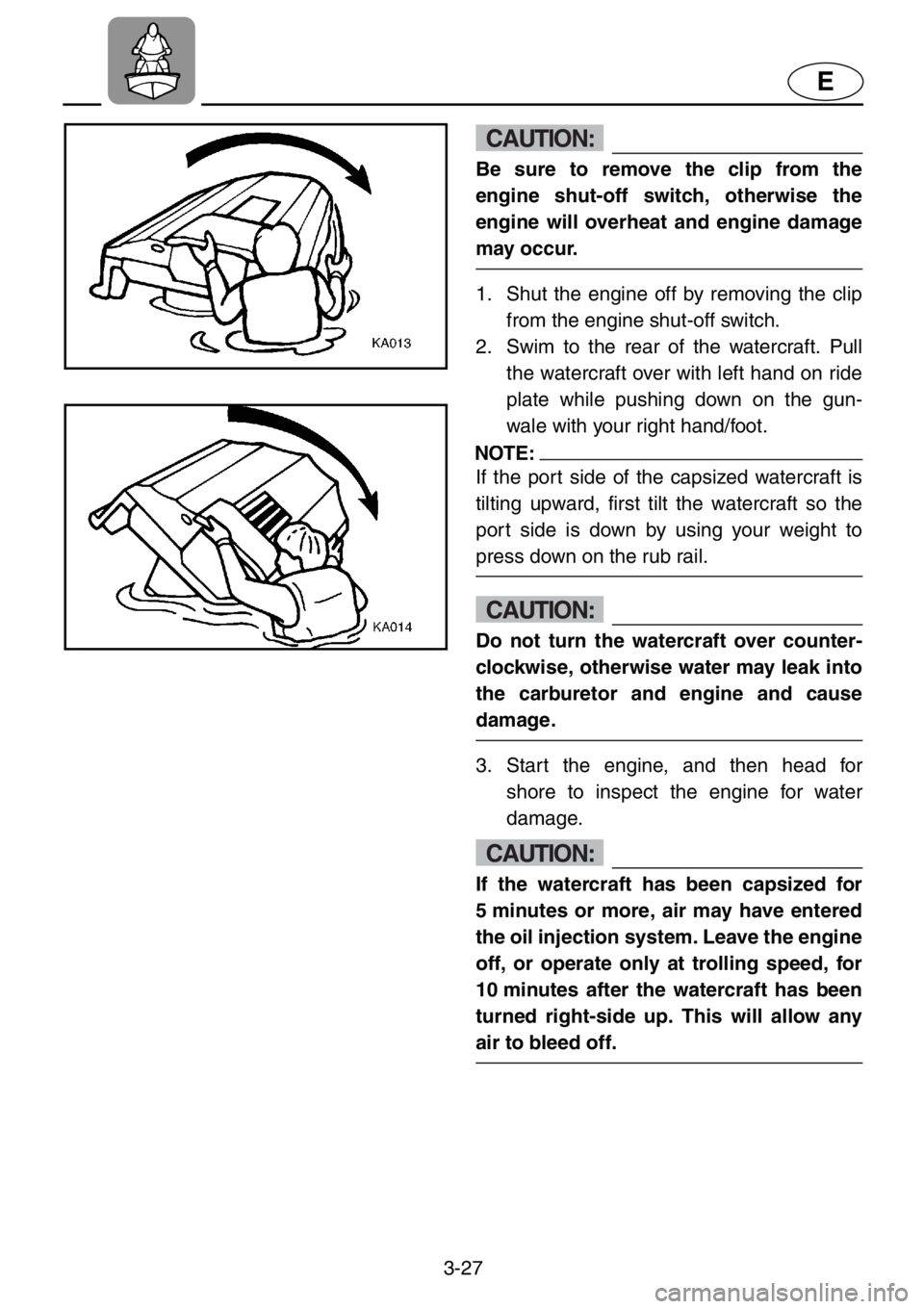Page 61 of 131
3-4
E
EJU00419a
Filling the oil tank
WARNING
●Do not add gasoline to the oil tank.
Fire or explosion could result.
●Oil in the bilge is a serious fire hazard.
Wipe up any spilled oil immediately.
CAUTION:
Do not allow the oil tank to become com-
pletely empty. If the oil tank becomes
empty the oil injection pump must be
bled to ensure proper oil flow, otherwise
engine damage may occur. If bleeding of
the oil pump is necessary, have a
Yamaha dealer bleed it.
1. Open the hood to access the oil tank
filler cap. Also, remove all seats to watch
the oil level. (See page 2-7 for hood, and
2-5 and 2-6 for rear and front seat.)
2. Open the oil tank filler cap, and very
slowly add engine oil to the oil tank.
3. Stop pouring when the oil just reaches
the bottom of the filler tube.
Oil tank capacity:
5.5 L (1.5 US gal, 1.3 Imp gal)
Page 62 of 131

3-5
E
EJU00422
Pre-operation checks
Pre-operation check list
Before operating this watercraft, perform the checks in the following check list. See the
accompanying text in this chapter for details on how to perform the checks.
WARNING
If any item in the pre-operation check list is not working properly, have it inspected
and repaired before operating the watercraft, otherwise an accident could occur.
NOTE:
Pre-operation checks should be made thoroughly each time the watercraft is used. This pro-
cedure can be completed in a short time. It is worth the time spent to assure safety and reli-
ability.
ITEM ROUTINE PAGE
Engine compartment Remove all seats and front storage compart-
ment to ventilate engine compartment. Check for
fuel vapors or loose electrical connections3-6
Bilge Check for water and fuel residue and remove if
necessary3-7
Throttle Check that the throttle lever springs back 3-10
Steering system Check for proper steering system operation 3-10
Shift lever and reverse gate Check for proper operation 3-11
Fuel and oil Check fuel and oil level and add if necessary
Check hoses and tanks for leakage3-6
Water separator Check for water and drain if necessary 3-7
Battery Check electrolyte level and battery condition 3-8
Front and rear seats Check that the seats are properly secured 2-5, 2-6
Hull/Deck Check the hull and deck for cracks or other dam-
age—
Jet unit Check for debris and remove if necessary 3-12
Fire extinguisher Check the condition and replace if necessary 3-9
Engine shut-off cord Check condition and replace if frayed or broken 3-12
Switches Check the start switch, engine stop switch and
engine shut-off switch for proper operation when
the watercraft is in the water3-13
Cooling water pilot outlet Check that water is discharged while the engine
is running when the watercraft is in the water3-13
Multifunction meter Check for warning indications and proper opera-
tion3-13
Page 63 of 131

3-6
E
EJU00426
Pre-operation check points
Engine compartment
Ventilate the engine compar tment before
each use.
To ventilate the engine compartment,
remove all seats and front storage compart-
ment. (See pages 2-5 and 2-6 for front and
rear seat, and 2-30 for front storage com-
partment.) Allow the engine compartment to
remain open for a few minutes to allow any
fuel vapors to escape. Also, check for loose
electrical connections.
WARNING
Failure to ventilate the engine compart-
ment could result in fire or explosion. Do
not start the engine if there is a fuel leak
or a loose electrical connection.
EJU00427-30a
Fuel and oil systems
Check the fuel system for leakage, cracks
or malfunctions before each use. (See page
4-9 for check points and correct proce-
dures.)
1. Remove the fuel tank filler cap to release
any pressure that might have built up in
the fuel tank.
2. Remove all seats and front storage com-
partment. (See pages 2-5 and 2-6 for
front and rear seat, and 2-30 for front
storage compartment.)
3. Check the fuel and oil levels in the tanks
and replenish if necessary. (See pages 3-3
and 3-4 for filling instructions.)
Page 71 of 131

3-14
E
EJU00676a
Operation
WARNING
Before operating your watercraft,
become familiar with all controls. Con-
sult your Yamaha dealer about any con-
trol or function you do not fully
understand. Failure to understand how
controls work could cause an accident or
prevent you from avoiding an accident.
CAUTION:
Make sure that stern drain plugs are
securely tightened before launching the
watercraft.
EJU00459
Engine break-in
The engine break-in period is essential to
allow the various components of the engine
to wear and polish themselves to the correct
operating clearances. This ensures proper
performance and promotes longer compo-
nent life.
CAUTION:
●For the first tankful of operation, pre-
mix a 50:1 mixture of fuel and oil (in
addition to the oil in the oil tank).
●After break-in, use straight gasoline
for normal operation.
1. Launch the watercraft and start the
engine. (See pages 3-16 to 3-18 for
engine starting procedures.)
2. Run the engine at the lowest possible
speed for 5 minutes.
Page 84 of 131

3-27
E
CAUTION:
Be sure to remove the clip from the
engine shut-off switch, otherwise the
engine will overheat and engine damage
may occur.
1. Shut the engine off by removing the clip
from the engine shut-off switch.
2. Swim to the rear of the watercraft. Pull
the watercraft over with left hand on ride
plate while pushing down on the gun-
wale with your right hand/foot.
NOTE:
If the port side of the capsized watercraft is
tilting upward, first tilt the watercraft so the
port side is down by using your weight to
press down on the rub rail.
CAUTION:
Do not turn the watercraft over counter-
clockwise, otherwise water may leak into
the carburetor and engine and cause
damage.
3. Start the engine, and then head for
shore to inspect the engine for water
damage.
CAUTION:
If the watercraft has been capsized for
5 minutes or more, air may have entered
the oil injection system. Leave the engine
off, or operate only at trolling speed, for
10 minutes after the watercraft has been
turned right-side up. This will allow any
air to bleed off.
Page 96 of 131
4-3
E
EJU00526a
Lubrication
1. Remove the spark plugs and pour
approximately one tablespoon of oil into
each cylinder.
2. Grease the spark plug threads and rein-
stall the spark plugs.
3. Crank the engine within 3 seconds using
the starter switch.
4. Lubricate all cables such as the throttle,
choke, and steering cables.
5. Lubricate the areas of the watercraft
specified under Lubrication points on
page 4-15.
EJU00528b
Fuel system
WARNING
Gasoline is highly flammable and explo-
sive. A fire or explosion can cause
severe injury or death. Shut off the
engine. Do not smoke. Avoid spilling
gasoline.
1. Place the fuel cock in the OFF position.
2. Drain the fuel tank by using a siphon.
Page 116 of 131

4-23
E
EJU00588
Specifications
MODEL
ITEMUnit XLT1200
WATERCRAFT CAPACITY
Maximum people on board Number of people 3
Maximum load capacity kg (lb) 240 (530)
DIMENSIONS
Length mm (in) 3,160 (125)
Width mm (in) 1,220 (48)
Height mm (in) 1,130 (45)
Dry weight kg (lb) 364 (803)
PERFORMANCE
Maximum output kW (PS) @ r/min 114 (155)@ 7,000
Maximum fuel consumption L/h (US gal/h, Imp gal/h) 64 (17, 14)
Cruising range at full throttle hr. 1.09
Trolling speed r/min 1,300–1,400
ENGINE
Engine type 2-stroke, L3
Engine displacement
cm
3 (cu in)1,176 (71.8)
Bore & stroke mm (in) 80.0 ×
78.0 (3.15 ×
3.07)
Compression ratio 5.9:1
Lubrication system Variable oil injection
Cooling system Water cooled
Starting system Electric starter
Ignition system Digital CDI
Spark plug BR8ES-11 (NGK)
Spark plug gap mm (in) 1.0–1.1 (0.039–0.043)
Battery capacity V-AH 12-19
Charging system Flywheel magneto
DRIVE UNIT
Propulsion system Jet pump
Jet pump type Axial flow, single stage
Impeller rotation Counterclockwise (viewed from rear)
Transmission Direct drive from engine
Jet thrust nozzle horizontal angle Degree 24 + 24
Jet thrust nozzle trim angle Degree -7, -2, 3, 8, 13
FUEL AND OIL
Recommended fuel Regular unleaded gasoline
Minimum octane rating PON
RON86
90
Recommended engine oil YAMALUBE 2-W, or an equivalent NMMA-
certified TC-W3 marine oil
Fuel tank capacity
Total L (US gal, Imp gal) 70 (18.5, 15.5)
Reserve L (US gal, Imp gal) 12 (3.2, 2.7)
Oil tank capacity L (US gal, Imp gal) 5.5 (1.5, 1.3)
Page 119 of 131

5-2
E
Engine runs irregu-
larly or stallsFuel Empty Refill as soon as possi-
ble3-3
Stale or contaminated Have serviced by
Yamaha dealer4-10
Choke Knob pulled Push fully in 2-10
Fuel filter Clogged or water
pooledHave serviced by
Yamaha dealer4-10
Fuel tank Water or dirt present Have serviced by
Yamaha dealer4-10
Spark plug Fouled or defective Replace 4-14
Incorrect heat range Replace 4-14
Gap incorrect Adjust 4-14
Spark plug cap Loose Connect properly 4-14
Cracked, torn, or dam-
agedReplace
—
Electrical wir-
ingLoose connection Tighten or connect
properly—
Carburetor Incorrect idle adjust-
mentAdjust idle
4-21
Clogged Have serviced by
Yamaha dealer—
Warning light or
indicator blinksFuel level Empty Refill as soon as possi-
ble3-3
Engine oil level Empty Refill immediately 3-4
Oil filter clogged Clean 4-11
Engine over-
heatedJet intake clogged Clean 5-4
Water temperature
sensor failedHave serviced by
Yamaha dealer—
Low battery
voltageBattery voltage low Charge 4-20
Battery terminal con-
nected wrongConnect properly
4-20 TROUBLE POSSIBLE CAUSE REMEDY PAGE